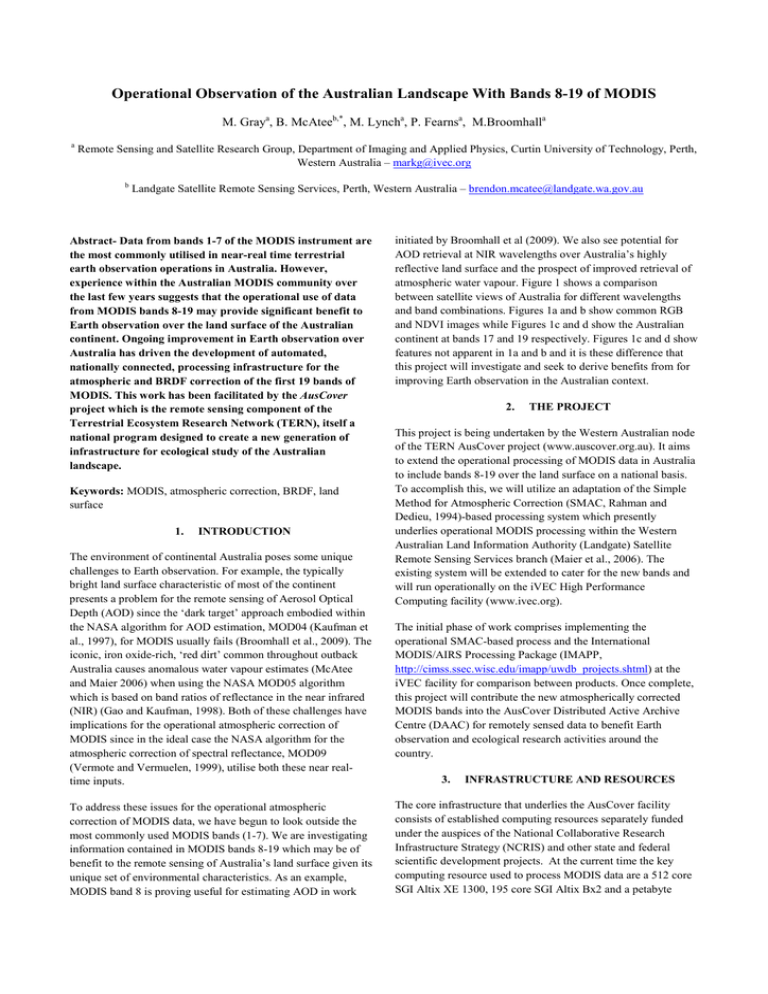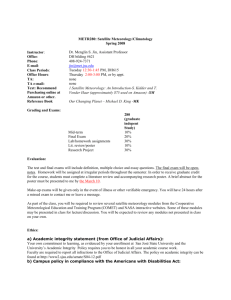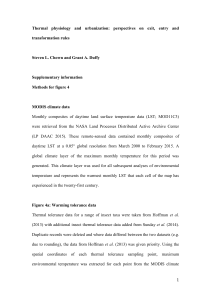Operational Observation of the Australian Landscape With Bands 8-19 of... M. Gray , B. McAtee , M. Lynch
advertisement

Operational Observation of the Australian Landscape With Bands 8-19 of MODIS M. Graya, B. McAteeb,*, M. Lyncha, P. Fearnsa, M.Broomhalla a Remote Sensing and Satellite Research Group, Department of Imaging and Applied Physics, Curtin University of Technology, Perth, Western Australia – markg@ivec.org b Landgate Satellite Remote Sensing Services, Perth, Western Australia – brendon.mcatee@landgate.wa.gov.au Abstract- Data from bands 1-7 of the MODIS instrument are the most commonly utilised in near-real time terrestrial earth observation operations in Australia. However, experience within the Australian MODIS community over the last few years suggests that the operational use of data from MODIS bands 8-19 may provide significant benefit to Earth observation over the land surface of the Australian continent. Ongoing improvement in Earth observation over Australia has driven the development of automated, nationally connected, processing infrastructure for the atmospheric and BRDF correction of the first 19 bands of MODIS. This work has been facilitated by the AusCover project which is the remote sensing component of the Terrestrial Ecosystem Research Network (TERN), itself a national program designed to create a new generation of infrastructure for ecological study of the Australian landscape. Keywords: MODIS, atmospheric correction, BRDF, land surface 1. INTRODUCTION The environment of continental Australia poses some unique challenges to Earth observation. For example, the typically bright land surface characteristic of most of the continent presents a problem for the remote sensing of Aerosol Optical Depth (AOD) since the ‘dark target’ approach embodied within the NASA algorithm for AOD estimation, MOD04 (Kaufman et al., 1997), for MODIS usually fails (Broomhall et al., 2009). The iconic, iron oxide-rich, ‘red dirt’ common throughout outback Australia causes anomalous water vapour estimates (McAtee and Maier 2006) when using the NASA MOD05 algorithm which is based on band ratios of reflectance in the near infrared (NIR) (Gao and Kaufman, 1998). Both of these challenges have implications for the operational atmospheric correction of MODIS since in the ideal case the NASA algorithm for the atmospheric correction of spectral reflectance, MOD09 (Vermote and Vermuelen, 1999), utilise both these near realtime inputs. To address these issues for the operational atmospheric correction of MODIS data, we have begun to look outside the most commonly used MODIS bands (1-7). We are investigating information contained in MODIS bands 8-19 which may be of benefit to the remote sensing of Australia’s land surface given its unique set of environmental characteristics. As an example, MODIS band 8 is proving useful for estimating AOD in work initiated by Broomhall et al (2009). We also see potential for AOD retrieval at NIR wavelengths over Australia’s highly reflective land surface and the prospect of improved retrieval of atmospheric water vapour. Figure 1 shows a comparison between satellite views of Australia for different wavelengths and band combinations. Figures 1a and b show common RGB and NDVI images while Figures 1c and d show the Australian continent at bands 17 and 19 respectively. Figures 1c and d show features not apparent in 1a and b and it is these difference that this project will investigate and seek to derive benefits from for improving Earth observation in the Australian context. 2. THE PROJECT This project is being undertaken by the Western Australian node of the TERN AusCover project (www.auscover.org.au). It aims to extend the operational processing of MODIS data in Australia to include bands 8-19 over the land surface on a national basis. To accomplish this, we will utilize an adaptation of the Simple Method for Atmospheric Correction (SMAC, Rahman and Dedieu, 1994)-based processing system which presently underlies operational MODIS processing within the Western Australian Land Information Authority (Landgate) Satellite Remote Sensing Services branch (Maier et al., 2006). The existing system will be extended to cater for the new bands and will run operationally on the iVEC High Performance Computing facility (www.ivec.org). The initial phase of work comprises implementing the operational SMAC-based process and the International MODIS/AIRS Processing Package (IMAPP, http://cimss.ssec.wisc.edu/imapp/uwdb_projects.shtml) at the iVEC facility for comparison between products. Once complete, this project will contribute the new atmospherically corrected MODIS bands into the AusCover Distributed Active Archive Centre (DAAC) for remotely sensed data to benefit Earth observation and ecological research activities around the country. 3. INFRASTRUCTURE AND RESOURCES The core infrastructure that underlies the AusCover facility consists of established computing resources separately funded under the auspices of the National Collaborative Research Infrastructure Strategy (NCRIS) and other state and federal scientific development projects. At the current time the key computing resource used to process MODIS data are a 512 core SGI Altix XE 1300, 195 core SGI Altix Bx2 and a petabyte datastore delivering real-time access to satellite data archives from disk and tape archive. It is anticipated that during 2011 we will have compiled a complete archive of the raw MODIS data spanning the beginning of MODIS operation to current observations. This dataset will be the basis for long time-series analysis and ondemand processing of MODIS products. Preliminary testing of MODIS processing shows that using iVec resources we can process one year of MODIS data (Aqua or Terra) to a set of derived products in approximately 2 weeks (elapsed time). 4. CURRENT STATUS MODIS processing software currently in use at the WA node of AusCover consists of the MODIS processing components of the SeaWIFS Data Analysis System (SeaDAS), the MODIS Level-1 Direct Broadcast processor (MODISL1DB), the International MODIS/AIRS Processing Package (IMAPP) and selected components of the International Polar Orbiter Processing Package (IPOPP). MODISL1DB is used to process both NASA provided five-minute granules and direct broadcast orbit passes to calibrated radiance and reflectance (Level 1B). Calibrated reflectance is used to compute atmospherically corrected reflectance using the standard MODIS surface reflectance Collection 5 algorithm (MOD09) for MODIS bands 1-7. To date one year of Aqua and Terra MOD09 has been processed for algorithm testing and validation. A SMAC reflectance algorithm that can be used to directly compare to MOD09 reflectance is under development. This algorithm produces corrected reflectance in a cylindrical equidistant projected in a Hierarchical Data Format file populated with metadata compliant with the Cooperative Ocean/Atmosphere Research Data Service (COARDS) standard. The initial SMAC implementation will produce MODIS bands 1-7 reflectance for long time series comparison with MOD09 for the Australian soil and vegetation types. The extension of SMAC processing for bands 8-19 and the validation of the derived reflectance can then be undertaken. A specific plan for validating SMAC band 8-19 reflectance incorporating AusCover validation protocols is in development. 5. CONCLUSION The project to operationally produce atmospherically corrected and validated surface reflectances from MODIS for bands 8-19 is well underway. We have produced some demonstration products (see Figure 1) and the system infrastructure is now in place so that operational, near-real time processing will soon begin. In the meantime we will commence comparing outputs between the available software packages in the iVEC environment and continue planning the ground validation campaigns to support the operational processing and data production. Figure 1. Comparison between the Australia continent viewed clockwise from top left as a) an RGB composite, b) an NDVI image, c) using MODIS band 17 (905 nm) and, d) MODIS band 19 (940 nm). REFERENCES Broomhall, M., McAtee, B., and Maier, S., 2009, “An investigation of the remote sensing of aerosols based on MODIS data for Western Australian conditions”. Springer Verlag series on Geoinformation and Cartography, Series Editors: Cartwright, W., Gartner, G., Meng, L., Peterson, M.P. ISSN:1863-2246, 2009. Gao, B-C., and Kaufman,Y.J., “The MODIS near-IR water vapor algorithm”. Algorithm Theoretical Basis Document. Remote Sensing Division, Code 7212, Naval Research Laboratory, 4555 Overlook Avenue, SW, Washington, DC 20375, 1998. Kaufman, Y., Tanrè, D, Remer,L., Vermote, E., Chu, A., and Holben,B. “Operational Remote Sensing of Tropospheric Aerosol over land from EOS moderate resolution imaging spectroradiometer”, Journal of Geophysical Research – Atmospheres, 102, 17051–-17067, 1997. Maier, S. W., Adams, J., Allen, A., Buchanan, A., Broomhall, M., Craig, R. L., Ferri, M., Gessner, U., Goessmann, F., Marsden, A. J., McAtee, B. K., Steber, M. T., and Stewart, B., “The MODIS near-real time processing system at Satellite Remote Sensing Services”. Proceedings of the 13th Australasian Remote Sensing and Photogrammetry Conference, Canberra, Australia, November 20 –- 24, 2006. McAtee,B. and , Maier,S.,” A comparison of algorithms for near real-time water vapour retrieval from MODIS “, International Journal of Remote Sensing 27, 5145–-5163, 2006. Rahman, H., and Dedieu, G., “SMAC : a simplified method for the atmospheric correction of satellite measurements in the solar spectrum”. International Journal of Remote Sensing, 15, 123— 143, 1994. Vermote, E. and Vermuelen,A., “Atmospheric correction algorithm: spectral reflectances (MOD09)”. Algorithm Theoretical Basis Document Version 4.0}, Department of Geography, University of Maryland, 1999.




